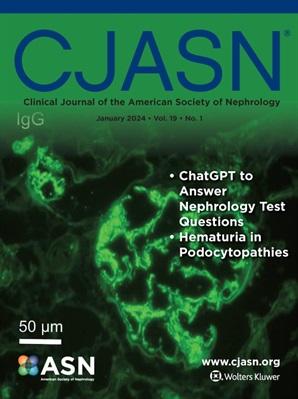A Randomized Controlled Trial of Video-Assisted Electronic Consent Versus Standard Consent for Percutaneous Kidney Biopsy.
IF 8.5
1区 医学
Q1 UROLOGY & NEPHROLOGY
Clinical Journal of the American Society of Nephrology
Pub Date : 2025-04-09
DOI:10.2215/cjn.0000000702
引用次数: 0
Abstract
BACKGROUND Informed consent is crucial in healthcare, as it respects and honors patient autonomy. However, the process of consenting a patient to a procedure or intervention is often unstandardized, leading to gaps in comprehension, which in turn affects decision-making. This study aimed to assess the patient-reported benefits of video-assisted electronic consent (eConsent) compared with the usual consent practices for percutaneous kidney biopsies (PKB). METHODS In this single-center, open-label, randomized controlled trial, consecutive patients undergoing PKB between July 2021 and January 2024 were randomized (1:1) to either video-assisted eConsent (intervention) or usual practice of consent (control). The intervention group accessed an eight-minute explanatory animation on an online platform covering the procedure, its risks, and pre- and post-biopsy care before providing digital consent. The control group was consented to by clinicians in the usual manner and signed a paper form. The primary outcome was questionnaire-based patient comprehension, with secondary outcomes including patient-reported experience, anxiety, and satisfaction with the consent process. RESULTS Of 178 eligible patients, 120 were enrolled (60 in each group), with a median age of 52 (IQR 34-65) years, 56% were female, and 59% had less than 12 years of education. Comprehension scores were significantly higher in the eConsent group, with participants answering on average three more questions correctly out of nine compared to the control group (p<0.001). Comprehension did not differ significantly by sex or education level, but younger patients scored higher. The eConsent group also had better comprehension of pre- and post-PKB care. No significant differences were observed in patient-reported experience, anxiety, or satisfaction between groups. CONCLUSIONS Video-assisted eConsent improves patient comprehension of PKB compared to usual consent practice without affecting patient experience, anxiety, or satisfaction. TRIAL REGISTRATION Australian New Zealand Clinical Trials Registry (ACTRN12621000768897).经皮肾活检中视频辅助电子同意与标准同意的随机对照试验。
知情同意在医疗保健中至关重要,因为它尊重和尊重患者的自主权。然而,同意病人接受手术或干预的过程往往是不标准化的,导致理解上的差距,从而影响决策。本研究旨在评估患者报告的视频辅助电子同意(eConsent)与经皮肾活检(PKB)的常规同意做法的益处。方法在这项单中心、开放标签、随机对照试验中,在2021年7月至2024年1月期间连续接受PKB治疗的患者被随机(1:1)分为视频辅助eConsent组(干预组)和常规同意治疗组(对照组)。干预组在提供数字同意书之前,在一个在线平台上观看了一个8分钟的解释性动画,内容包括手术、风险以及活检前后的护理。对照组按常规方式经临床医生同意,并在纸质表格上签字。主要结果是基于问卷的患者理解,次要结果包括患者报告的经历、焦虑和对同意过程的满意度。结果178例符合条件的患者中,入组120例(每组60例),中位年龄52岁(IQR 34-65), 56%为女性,59%受教育程度低于12年。eConsent组的理解分数明显更高,与对照组相比,参与者在9个问题中平均多答对3个问题(p<0.001)。理解能力在性别和教育水平上没有显著差异,但年轻患者得分更高。eConsent组对pkb前后的护理也有更好的理解。在两组患者报告的经历、焦虑或满意度方面没有观察到显著差异。结论与通常的同意做法相比,视频辅助同意可以提高患者对PKB的理解,而不会影响患者的体验、焦虑或满意度。澳大利亚新西兰临床试验注册中心(ACTRN12621000768897)。
本文章由计算机程序翻译,如有差异,请以英文原文为准。
求助全文
约1分钟内获得全文
求助全文
来源期刊
CiteScore
12.20
自引率
3.10%
发文量
514
审稿时长
3-6 weeks
期刊介绍:
The Clinical Journal of the American Society of Nephrology strives to establish itself as the foremost authority in communicating and influencing advances in clinical nephrology by (1) swiftly and effectively disseminating pivotal developments in clinical and translational research in nephrology, encompassing innovations in research methods and care delivery; (2) providing context for these advances in relation to future research directions and patient care; and (3) becoming a key voice on issues with potential implications for the clinical practice of nephrology, particularly within the United States. Original manuscript topics cover a range of areas, including Acid/Base and Electrolyte Disorders, Acute Kidney Injury and ICU Nephrology, Chronic Kidney Disease, Clinical Nephrology, Cystic Kidney Disease, Diabetes and the Kidney, Genetics, Geriatric and Palliative Nephrology, Glomerular and Tubulointerstitial Diseases, Hypertension, Maintenance Dialysis, Mineral Metabolism, Nephrolithiasis, and Transplantation.

 求助内容:
求助内容: 应助结果提醒方式:
应助结果提醒方式:


